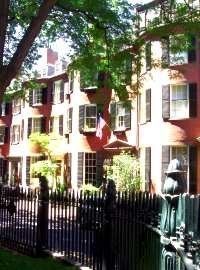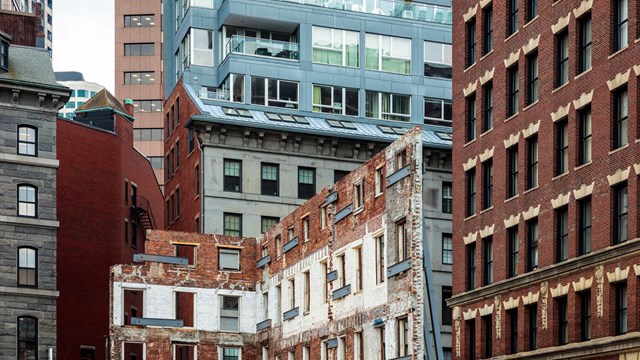
In a city with a history as rich and storied as Boston's, it's no surprise that history is told in large part through its architecture. The face of that architecture, quite literally, can be found in the facades that give each building its character, charm and personality. Within each neighborhood, Boston's buildings are as different as the people living within them.
From historical buildings that have stood for centuries to today's newest architectural statements, each building's façade is an important part of the story it tells. That is why the proper care and restoration of these structures is so important to maintaining the character and richness of not only each residential building but also of each neighborhood in which it stands.
"We seek to preserve character defining features," says Ellen Lipsey, director of The Boston Landmarks Commission (BLC). "We seek to preserve the physical features embodied in each building since all of these buildings are from different periods."
The Boston area, happily, is filled with engineers and architects intent on maintaining, improving and enriching the exterior look and appeal of the city's residential dwellings. And they're well-versed in the wide array of building materials they may encounter.
"You get a little bit of everything in this city," says Ralph Noblin, PE of Noblin & Associates, LC, Consulting engineers in Bridgewater. "There are old brownstones. There's brick and there's stone. You get curtain wall construction—glass and panels with a modern look." There's also pre-cast stone, sometimes known as manufactured stone. "There's even wood," he says. "Hundred-year-old cedar and fir."
In fact, much of Boston's residential housing includes at least some wood. "Most residential is detached or garden-style," says Bob Burns, principal of Burns & Associates Engineers in Portsmouth, New Hampshire, "with maybe three or four units sharing a space." These "double- or triple-deckers" are most often found in Dorchester, South Boston and Mattapan. The types of high-rise residential buildings that are so prominent in places like New York City have really only started to grow in the Boston area within the last decade. "Boston underwent major redevelopment about 20 years ago," Burns says, which is when many new co-op and condo buildings were erected.
Where Problems Arise
Each style of façade, from brick to stone to wood, offers its own set of advantages and its own set of drawbacks when it comes to longevity, quality and toughness.
Brick, for example, can last decades and even centuries if properly cared for and preserved. Sometimes the older buildings are even tougher than today's buildings, says Noblin. In the old brick buildings, "A brick wall was four, six or eight bricks thick. Hopefully the wall was deep enough so that water didn't get into the living area. Then on nice days, the water would dry out." The proper handling of water is truly the key to façade well-being up and down the line. Water, in construction, is the nemesis and the enemy against which builders must always be vigilant.
Starting in the 1950s, more Boston buildings began cutting back on the layers of brick used, says Noblin. That led more water to find its way into construction cavities, causing leak issues and even more advanced drainage and ventilation problems later if left untouched.
"[Leakage issues] need to be handled properly with flashing, which directs it out through the weep holes," Noblin says. "Most modern brick buildings leak because there's too much emphasis on making it pretty and not enough on flashing."
Water can also cause damage in today's modern glass-and-steel structures. "Glass often fails because moisture develops between two panes of glass," Noblin says. "That's when you get that frosty glazing."
By the time a building develops a problem with leaks and water damage, its troubles have probably been going on for quite a while. "Leaks are the last sign of trouble," Noblin says. "If the water is getting into the building, then the water has come through several problem areas. There's clearly a significant problem if you can see a leak."
Moisture is almost always a presence within a building. It's the question of what happens after it enters the building that is most important. "It's not unusual for some amount of water to get into a building," Burns says. "It's to be expected. But you need opportunities for it to dry out." There needs to be sufficient structural ventilation in buildings, "so that moisture can vent itself out. Moisture will evaporate and no harm is done."
Sometimes those leaks start because of another major façade issue: mortar, caulking and sealants in general. In a brick building, trouble can arise because of the degradation of the mortar between the bricks. Today's builders are using caulking rather than mortar.
"Buildings move in relation to temperature and moisture," Noblin says. "Caulking is much more forgiving than mortar." Finding the proper sealants to fill the gaps between stone pieces is just as important. "In stone buildings, like in Chicago and Washington D.C., you'll see that it's the joints between the stones that need attention," Noblin says. "Stone lasts a long time, but it's the joints that need to be attended to."
Solving Pesky Problems
Finding a solution to leaks, frosty glass and sealant issues can be quite a balancing act when maintenance needs butt heads with maintaining a building's historic character and charm.
Perhaps the most common repair is the re-pointing of a brick building—replacing loose mortar where it's failing or coming free from its bricks. Burns advises against replacing old, deteriorated mortar with just any old type of mortar, especially in historically significant buildings. He suggests using special mortar formulations that are softer and tend to expand and move with the bricks. That way, there'll be less degradation over time, and the mortar will not contribute to the cracking of any of the bricks around it, which can happen when the mortar mix is too hard or stiff. "We match [our mortar] not only for color but also for structural integrity," Burns says.
Noblin urges people to stay on top of caulking and coatings. It will help prevent water from rotting out wood and also preserve steel framing. "In any city near the ocean, the atmosphere is corrosive to begin with," he says. "In lots of buildings built in the last 40 years, the skin of the building was made of galvanized steel. The studs were particularly exposed to moisture cycling. It will rust without [proper care]. They've had big sections of wall just blow off buildings in Boston. Aging cities are the worst-case scenario, to literally have sections of buildings fall off."
Planning Ahead
One way to avoid costly façade repairs and restorations is to maintain your building's façade and inspect it on a regular basis. Visual inspections by your maintenance or management staff are imperative. "You want to look for cracks in brick or cracks in stone," Noblin says. "You might notice small chunks of brick on the ground. You want to look for signs that something is wrong or off." He suggests doing an informal inspection annually and a more formal inspection every five years.
The more windows a building has, the more opportunity there is for trouble as well, so taking a close look at the spots where the windows fit into the façade can be important as well.
Boards must plan ahead financially for repairs and renovations, too. For example, "You have to lay out a five or 10-year plan to do re-pointing work," Burns says. "It's a never ending process with these older buildings. What looks okay today might not be in five or 10 years. It can be an accelerated process." Burns adds that it's important to have an engineer come in to conduct a capital reserve study—and it's imperative that the façade be part of that evaluation.
Being aggressive when it comes to preventing problems will always pay off in the long run, something that's vital to remember when it comes to preserving and protecting the rich, varied architectural charm of a city as diverse and historically important as Boston.
Liz Lent is a freelance writer and a contributor to The Boston Cooperator.






Leave a Comment